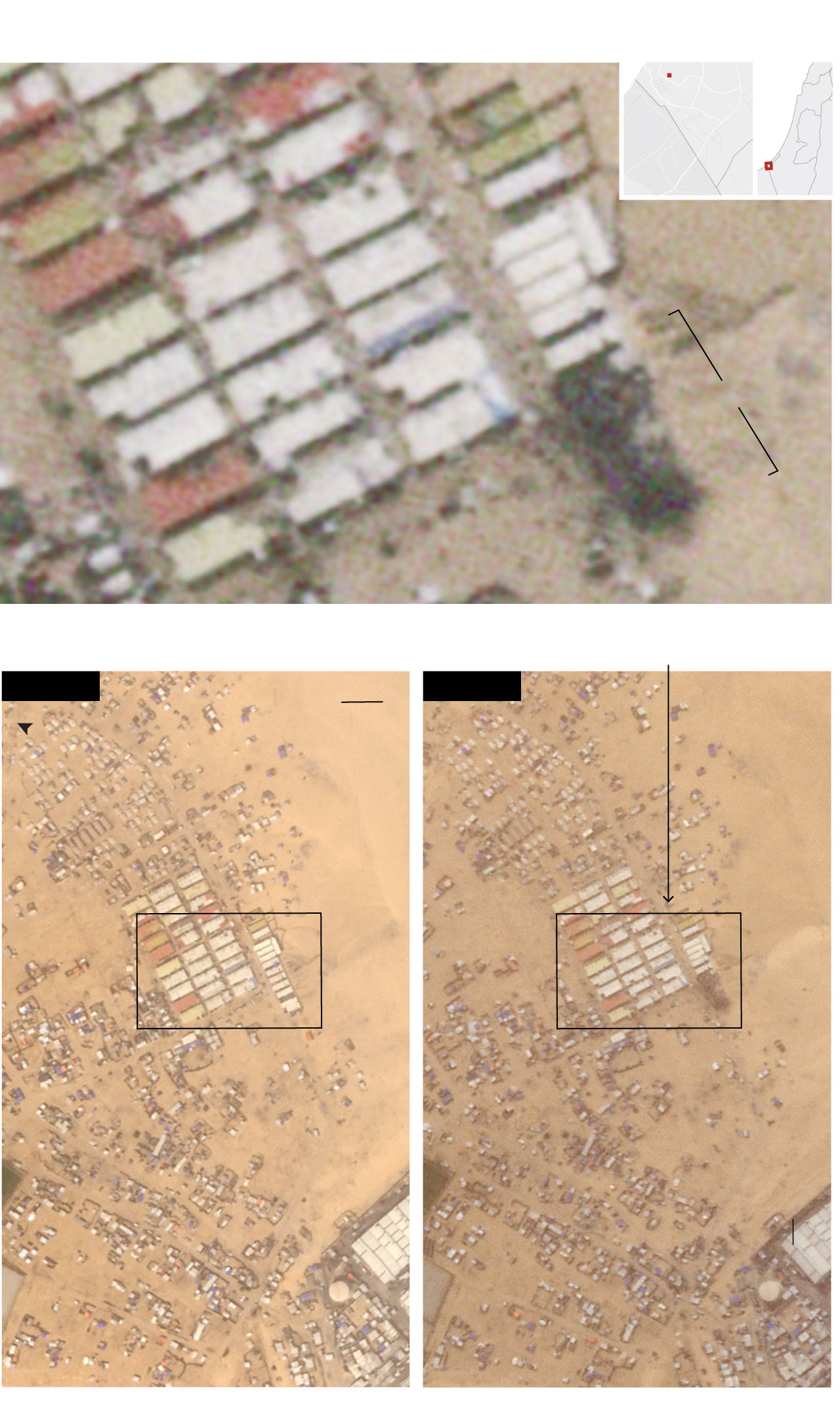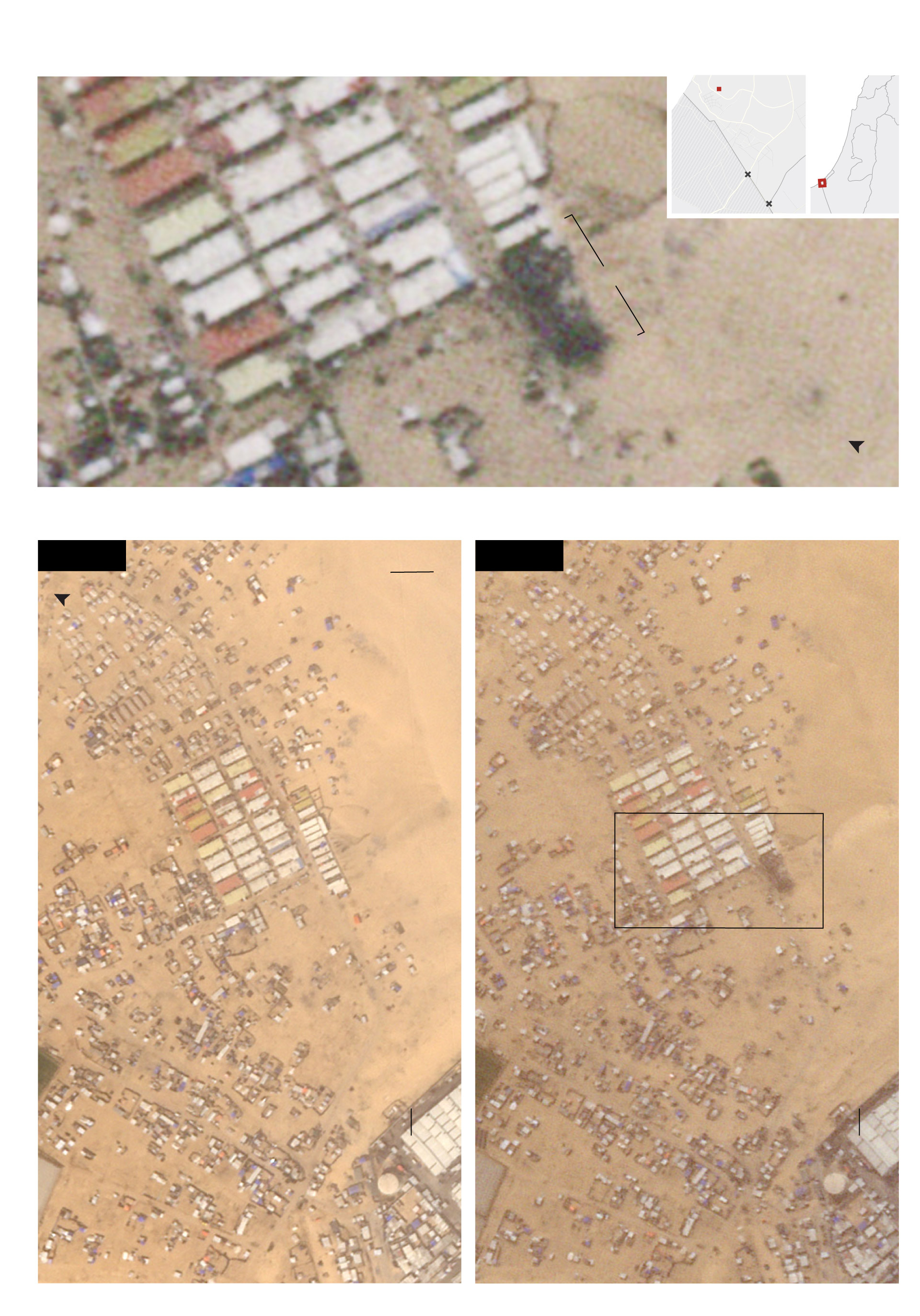An Israeli military investigation into a deadly strike at a tent camp in Rafah this past weekend that killed 45 and drew worldwide condemnation suggested that a secondary explosion started a blaze that led to many of the deaths, an official said Tuesday.
“Our munition alone could not have ignited a fire of this size,” he said, adding that the ongoing investigation was looking into the possibility that “secondary explosions” linked to “weapons stored in a compound next to our target,” may have ignited the deadly blaze.
Hagari added that the Israel Defense Forces took “a number of steps prior to the strike to avoid civilian casualties,” including aerial surveillance. He called the fire “unexpected and unintended” and expressed “deep sorrow for this tragic loss of life.”
“Our war is against Hamas, not against the people of Gaza,” he said.
GET CAUGHT UP
Summarized stories to quickly stay informed
Nearly 1 million people have fled the southern Gazan area of Rafah in the past three weeks, the U.N. Relief and Works Agency (UNRWA) that aids Palestinian refugees reported, with that number expected to rise after the weekend’s strike.
UNRWA tweeted Tuesday that there was “nowhere safe to go & amidst bombardments, lack of food & water, piles of waste & unsuitable living conditions” in Rafah. “Day after day, providing assistance & protection becomes nearly impossible,” it continued. The agency called for an immediate cease-fire.
Israeli forces seized control of the Rafah border crossing in early May, shutting off the flow of aid through the crucial passage and forcing hundreds of thousands of civilians to flee. Israel has since expanded its ground incursion and intensified its bombardment of the area, despite assurances given to the United States of an “operation of limited scope, scale and duration,” National Security Council spokesman John Kirby said at the time.
Despite the international outcry after Sunday’s operation in Rafah, an UNRWA official in the city’s Tal al-Sultan neighborhood said Israeli operations appeared to have expanded overnight into built-up areas in the west of the city. “They have fired shells into areas way outside the evacuation zone,” UNRWA’s Sam Rose told The Washington Post, referring to Israeli tanks. Rose added that a shell hit a mosque near the refugee agency’s offices in central Rafah.
There was also another lethal overnight strike in the tented encampment next to UNRWA’s logistics base, where the Sunday night strike took place, Rose said.
At least 21 people were killed and 64 injured, according to the Gaza Health Ministry, in strikes in the west of Rafah. Gaza’s civil defense crews in Rafah were subjected to three attacks since midnight Tuesday while carrying out their job, the agency said in a statement, adding that bomber planes fired on crews and that snipers targeted crew members and an ambulance west of Rafah. Artillery shells were also fired at civil defense members, accompanied by the Palestinian Red Crescent, while trying to retrieve injured people near the Zoroub roundabout, the ministry said.
Mohammad al-Mughair, head of the Civil Defense Equipment Unit, told The Post that more than 25 people were killed overnight and 43 injured — most of them children, women and the elderly.
The Israel Defense Forces did not immediately respond to a request for comment on these reports but said in a statement Tuesday that it was continuing operations in Rafah, including in the Philadelphi Corridor area, as well as in Jabalya, northern Gaza and central Gaza.

Tal al-Sultan tent camp after
and before IDF’s strike
Makeshift accomodation
(visible in satellite from early January)
MAY 27
Approx. 130 ft.
Damaged
area
N
Detail
Med.
Sea
GAZA
Rafah
GAZA
EGYPT
ISRAEL
Makeshift tents
Area of detail
UNRWA
WAREHOUSE
100 FEET
MAY 26
UNRWA
WAREHOUSE
Source: Planet Labs PBC

Tal al-Sultan tent camp after
and before IDF’s strike
Makeshift accomodation
(visible in satellite from early January)
MAY 27
N
Approx. 130 ft.
Damaged
area
Detail
Med.
Sea
GAZA
100 FEET
Rafah
GAZA
EGYPT
ISRAEL
Makeshift tents
Area of detail
UNRWA
WAREHOUSE
MAY 26
UNRWA
WAREHOUSE
Source: Planet Labs PBC

Tal al-Sultan tent camp
Detail
Med.
Sea
GAZA
Rafah
GAZA
EGYPT
ISRAEL
Makeshift accomodation
(visible in satellite from early January)
Approx. 130 ft.
Damaged
area
Before and after IDF’s strike
AREA OF DETAIL
MAY 26
MAY 27
100 FEET
N
Makeshift tents
UNRWA
WAREHOUSE
Source: Planet Labs PBC

Tal al-Sultan tent camp
Detail
Med. Sea
Tel al-Sultan
Rafah
EGYPT
Kerem
Shalom
crossing
GAZA
Rafah
crossing
ISRAEL
Makeshift accomodation
(visible in satellite from early January)
Approx. 130 ft.
Damaged
area
N
Before and after IDF’s strike
MAY 26
MAY 27
100 FEET
N
Makeshift tents
Area of detail
UNRWA
WAREHOUSE
UNRWA
WAREHOUSE
Source: Planet Labs PBC
Israeli Prime Minister Benjamin Netanyahu on Monday called the Sunday night strike on Rafah a “tragic accident,” a departure from public Israeli military statements that referred to the strike as “intelligence-based.” But the acknowledgment did little to quell international outrage over the attack.
Martin Griffiths, the United Nations undersecretary general for humanitarian affairs and emergency relief coordinator, emphasized how the attack showed there were no safe havens in Gaza.
“Not shelters. Not hospitals. Not the so-called humanitarian zones,” he said in a Monday statement. “Whether the attack was a war crime or a ‘tragic mistake,’ for the people of Gaza, there is no debate,” his statement continued. “What happened … was the latest — and possibly most cruel — abomination.”
More than a dozen international aid agencies, among them Oxfam and the Norwegian Refugee Council, signed a joint letter calling on all members of the U.N. Security Council to enforce an order last Friday by the International Court of Justice for Israel to halt its military operations in Rafah.
Despite the legal order, the letter said, “the bloodshed has continued.” A failure by the UNSC to act “would undermine global trust in the primacy of international law,” the letter added.
Here’s what to know
Spain, Ireland and Norway formally recognized Palestine as a state on Tuesday, a week after they announced their intentions to do so. “The Government recognises Palestine as a sovereign and independent state and agreed to establish full diplomatic relations between Dublin and Ramallah,” Ireland’s government said in a statement, noting the “tragic backdrop to today’s announcement.” Norway said the recognition “represents a milestone in Norwegian-Palestinian relations.” Spanish Prime Minister Pedro Sánchez called it a “matter of historical justice” and necessary to “achieve peace.” Officials in Israel have criticized the decisions.
The United Nations Security Council will meet Tuesday to “discuss the situation in Rafah,” according to British representatives to the United Nations. The meeting will be a “closed session,” they said, and therefore not open to press. Hamas in a statement Tuesday said the “the international community and the Security Council must act urgently and take a clear decision to stop these flagrant violations of international laws.”
Egypt is investigating a shooting incident in the Rafah border area that killed a member of its security forces Monday. Israel confirmed a shooting and said it was also investigating. A former Egyptian official told The Washington Post on Monday that details of the incident could be outlined by a joint committee Tuesday.
Belgian Deputy Prime Minister Petra De Sutter called for sanctions on Israel after a decision to convene a European Union-Israel council to assess Israel’s compliance with an E.U. agreement that obligates it to respect human rights.
At least 36,096 people have been killed and 81,136 injured in Gaza since the war started, said the Gaza Health Ministry, which does not distinguish between civilians and combatants but says the majority of the dead are women and children. Israel estimates about 1,200 people were killed in Hamas’s Oct. 7 attack, including more than 300 soldiers, and it says 287 soldiers have been killed since the launch of its military operations in Gaza.
Heba Farouk Mahfouz and Lior Soroka contributed to this report.








